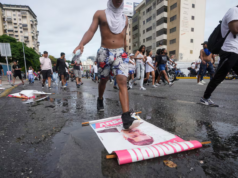By Francesc & El Quico
In this dispatch from Sāo Paulo, the authors argue that, in a period of class fragmentation, conflict has become the only “base” left upon which to build. In Bolsonaro’s Brazil, this truth applies not only to proletarian organization, but also to the neo-fascism in power.
We live in a time completely shot through with conflict.1 At the most spectacular level, democracy under the rule of Jair Bolsonaro resembles a hydra gone mad, its heads (executive, legislative, judiciary) mutually devouring each other in a self-consuming battle. It’s common knowledge that this infra-institutional conflict forms the very engine of Bolsonarism. As president, Bolsonaro projects an image of himself as the very embodiment of society’s revolt against the institutions. The expression “rebellion within order” signifies precisely a hypostatized anti-institutional sentiment.2 Every day a new enemy inside the state is selected: Toffoli, Maia, Dória…3 Why? Let’s recall that in June of 2013 a mass uprising against the state took place, catalyzed by a single specific policy. The insurgency that popped off in the streets of this country seven years ago, which at the time was intimately bound up in the relatively invisible conflicts animating the everyday life of capitalist exploitation, was then progressively transfigured and pointed back against institutions that fulfill, in this sense (and ironically) the role expected of them: to assimilate, absorb, and internalize society’s open wounds. In this case, this came at the high cost of compromising any condition of governability. Bolsonaro only consummates this process — rage against institutional rot has entered the institutions themselves, in the figure of the president. However, it turns out that the “anti-establishment” sentiment against the state within the state is not itself, and cannot be, the same insurgency that emerged on the streets and in the daily life of capitalist exploitation in 2013.
Even when Bolsonarism aims to attack opponents outside the traditional political representations, this attack still remains subordinate to the fight waged upstairs: the target is Globo Television Network, for example, an ally of the “old politics” and the Supreme Court, which has hindered government action. In this sense, perhaps Bolsonaro’s limit is precisely to have sequestered the indignation inside the state a little too much, converting himself into a totem of rebellion, so that his base4 remains more or less amorphous, glued to the figure of the president who fights the real battle inside the institutions (his voters, down here, do the work of sidekicks, so that he can win up there). It is this completely heteronomous relationship with their charismatic leader that perhaps explains the apparently hypnotic sleepwalking of his followers, which is so impressive. The real danger begins with that providential “loss of control” of the grassroots support base, redirecting the conflict from inside the institutions back onto society, so that Bolsonarism becomes sufficiently dissociated from Bolsonaro himself. The danger exists, but for now what we see is the opposite: the Bolsonarist “base,” besides shrinking numerically in the streets — and this during a decisive moment, in the middle of the pandemic, when it should finally “appear” — reveals itself to be increasingly dependent on commands emanating from the figure of the president. Bolsonaro plays upon the field of expectations, but he can precipitate himself under pressure, imposing on his base a forced organicity.

It is true that Bolsonaro conveys a level of self-confidence as if he had an army behind him. Perhaps he understands that this is not a collection of people who are ever-available. Manolo’s article correctly speaks of a base that “exists and does not exist,” and, as one of its readers suggested, this definition is partly reminiscent of the relationship of the MPL (Free Fare Movement)5 with its “base” in 2013, which, as it were, existed only on the horizon. It was believed that while this base never presented itself as enumerated and labeled, it could erupt into action if the right tactics were applied at the right moment. Something of this calculation may indeed exist in Bolsonaro’s horizon, but with a fundamental difference that Manolo also emphasized: Bolsonaro didn’t coast into power on the coattails of an organic grassroots movement. On the contrary, he uses the machinery of the state itself to fabricate his base, which creates the additional difficulty of engineering a similarly fundamental “loss of control.” He must somehow trigger the sort of “self-movement” of his base without which no fascism is possible, nor — it should be said — revolution either.
We mustn’t neglect to add, of course, that the far-right made its debut in the streets well prior to Bolsonaro’s election, during a series of massive actions in 2016 defending the impeachment of Dilma Rousseff. However, it should be acknowledged that this power of mobilization was effectively disarticulated after the electoral victory, so that when the indignation against the “corruption” of the regime entered the institutions themselves, embodied in the figure of Bolsonaro, it stagnated. Thus, in the second year of his government, in the midst of a pandemic, the question is no longer whether Bolsonaro will succeed in increasing the real mobilization power of the far-right in the streets, but why has he not succeeded so far?
The fear of conflict in our ranks
Perhaps one of the most harmful effects of Bolsonarism resides in its power to affect the very spirit of a considerable part of the left, immobilizing its capacity to imagine conflicts that do not end up turning against itself. It is already clear that one of the central contradictions of the current government resides in the fact that it depends on the deepening of the institutional crisis. Its aim is to displace the burden of the crisis onto governors, mayors and the Supreme Court. Now, faced with this scenario, what’s the left’s response? Everything revolves around the strategy of slowing down institutional deterioration, actively working to “credibilize” the regime that Bolsonaro implodes. The idea that our misfortunes all result from “corruption” and institutional rot is a Cain who only finds reason to exist in the permanent murder of his brother Abel. This logic is resurrected every time the left asserts, to the contrary, that misfortune can be fought through the state alone.6 Never has the left’s foolish statism been so dangerous, because the institutional war that undermines the regime’s credibility is the enemy’s battleground, into which the left finds itself repeatedly drawn and defeated. This is an ambush that the government has set for its opposition, and it has worked. The more time that is wasted on statist dreams, the more Bolsonaro is given to get through the current turbulence and come out strengthened. Meanwhile the conflict, partially held within the confines of the institutions, will be reopened in the bosom of society, encountering a left that knows nothing but babbling and cackling legalism, while a social war is prepared in full swing behind its back.

But the fear of conflict, on the left, is not just any fear. It has everything to do with a certain ignorance of the very form of the social conflict that is feared, to the utter lack of references by which we can even begin to conceive it. The tendency of the system to sequester anti-systemic sentiment inside state institutions has also jeopardized the assumption that our strategic frame of reference should be sought on the terrain of the real relations of exploitation. It is not easy today to “locate” the proletariat, to circumscribe it minimally in reality, except by relying on approaches that stop right where they ought to start, that is, with the mere description of the empirical results of broad processes of deregulation we find at work in digital platforms, automation, outsourcing, informality, etc. Such approaches are already determined, from the get-go, by a prior, positive image of the “worker.” This attachment to the image of the proletariat is notable, for example, in the proliferation of heroic photographs of app deliverers on social media. But the conflict isn’t here. We need to take two steps back, and look at the way in which workers impose forms of silent resistance within the process of disintegration of the world of work (or recomposition). Yet a lack of interest in such concrete and silent forms of resistance often corresponds to a habit of substituting ideology for material relations. When the image of the heroic “precarious worker” is abandoned, and one is instead confronted with the reality of the poor individual with a delivery bag on his back, the opposite diagnosis is then made of a disintegrated subjectivity with intrinsic fascist tendencies.
This is how we must understand the periodic and untimely resurrection of the idea of “base building” (“grassroot” or “rank and file organizing”) and of certain quasi-Franciscan notions of “solidarity” and “self-discipline.” What is at issue here is not merely a desire to manage a mass of miserable people, but something even worse: the call for grassroots organization signals an effort to produce a base where it barely exists anymore. Beneath the arguments for fighting precarization, the defense of “increased regulation” in labor relations often disguises a fear of “losing sight” of a proletariat that has supposedly always been there, within reach. In the midst of a pandemic with more than 130,000 deaths7, the current dynamic of labor relations thus comes to appear in all its frightening absurdity (for instance, as the logic of viração or “just getting by”8 intensifies alongside the slowdown of the economy amidst pandemic chaos). This is precisely why this dynamic becomes rife with conflict. The world of work presents itself as an intense war of movement, yet no matter how vulnerable it is on the battlefield, the left refuses to abandon its trenches, its microscopic organizing efforts here and there. This also helps to explain the present immobility of social movements, insofar as the profound changes in the world of work make their bases virtually extinct, no matter how numerically robust they are in actuality. It is this state of affairs, already acknowledged in certain corners, that reaches its paroxysm in the pandemic.
If the “base,” understood as a group of workers in more or less stable relations, constitutes the “terrain” on which militants must move, we must conclude that the terrain today is deeply unstable. When app drivers gather to obstruct traffic on a major thoroughfare (or the shipping docks of shopping centers, as occurs now) demanding increased freight rates, like lightning in a blue sky, a kind of “base” is formed there, which dissolves as soon as the action declines. Naturally, a “base” that exists exclusively in such moments of confrontation does not allow itself to be managed, it is even an “anti-base.” We are still not truly capable of comprehending the sense of urgency that permeates the subjectivity of a proletariat fighting a life-or-death struggle for survival. Here again, overcoming this obstacle would require a detailed and systematic knowledge of the repertoire of resistances that this proletariat imposes upon the social disintegration that engulfs it in the daily life of exploitation. The subjectivity that emerged in the streets of Hong Kong, with the Yellow Vests in France, in the streets of Chile and Minnesota cannot be understood without averting our gaze from the glowing flames of torched cars to the daily and invisible relations of exploitation where this same subjectivity is generated. The explosion of revolt in the streets of the United States in 2020 was anticipated by major strikes and struggles on the terrain of labor relations.9 The traditional means of association continue to lose their pertinence in the everyday life of elementary social reproduction, without anything replacing them, giving way to advanced forms of desocialization countered only by silent and fragmented resistance tactics that, every now and then, flare up wildly.

Let’s imagine, for a second, that the eruption of labor conflicts on various scales were not simply a stopgap mechanism aimed, for example, at compensating for wage losses (even though such “demands” clearly still remain central): the idea that such struggles end up serving a purely regulatory and rebalancing role in labor relations still presupposes a horizon of “victories” to be accumulated, within a broader perspective of progressive integration that any worker today knows, however, is pure illusion. In many cases, conflict erupts as a means to curb total disintegration. For example, app drivers impose resistance to the growing atomization of the solitary service they perform by developing contact networks among themselves through WhatsApp groups, by means of which a certain collective “self-image” is precariously produced. Such groups often gather together drivers from far flung states, with the result that their members won’t even know each other — yet there they are: depersonalized, reduced to the common condition of “Rappi courier,” the “pure” proletarian, perhaps, if that’s what one is looking for. WhatsApp groups also serve, of course, to collectively circumvent the absence of minimum working conditions; yet when these same drivers then appear in a collective action demanding an increase in the amount paid per delivery or incorporating themselves into a larger insurgent mob, such precarious everyday group self-organization finds itself mobilized and refunctionalized. Such mechanisms, forged in the crush of everyday life to cope with desocializing pressure, also often lead in roundabout ways to increased engagement at work. Work pages that proliferate on Facebook, entitled “Depression Gas Jockeys,” “Depression Call Center Workers,” “Depression Stockists,” etc. simultaneously share ironic memes about the absurd routine of work alongside motivational content to produce even more engagement with this same absurd field. One can no longer plot quietly in one’s spare time, if this was ever possible. The drawback, therefore, is that this duality of the instruments of collective resistance is a big part of why the latter do not appear as such: here we are a long ways from the repertoire of methods of struggle that syndicalism once enveloped, and that appeared to the worker’s eyes precisely as a means of struggle and as instruments constituting a collective self-image.
We would be wrong, therefore, to claim that there is no transition or any continuity between moments of open conflict (whether these be local affairs, or massive insurgencies in the streets) and “normal life,” where confrontation again becomes invisible, subterranean. Because the boundaries between forms of association aimed at collective struggle and those designed to further engage the worker in exploitation have blurred. This helps to explain why revolts such as that of the Yellow Vests in France escalate immediately, taking on insurrectionary forms without any mediation (with no “before and after”). This may also help to explain the impressive longevity of recent street protests in Chile, for example. The prospect of suspending such open conflicts and returning to normality depends directly on the possibility of consolidating some sort of “gain” out of the whole experience, especially at the level of organization. Yet this is precisely what seems impossible today, given that normality today appears as the absolute negative of insurrection, and insurrection “cannot leave anything outside itself” (Debord).10
Conclusion
At this moment, as we stand at the epicenter of the Covid-19 pandemic, and with no coordinated and rational action on the part of governments, the desocialization prevailing in labor relations has become unbearable in the eyes of many. It has consequently engendered a strong desire to preserve bonds of solidarity, however minimal these may be, outside of the conflictual nature of relations of exploitation, especially given that the work world now appears in all its destructiveness, as people’s need to make money ensures that they continue to circulate, and continue to get infected. The pandemic works as a shock of reality, in the sense that it reveals how much the left, in general, remains external to the world of contemporary labor. This explains the mystification here and there of certain schematic notions, such as the idea of a general “self-discipline” of the proletariat that is confused with a strange “duality of power” — strange, because it is achieved as if by magic, skipping over the struggle against the capitalists in the immediate terrain of the relations of exploitation in order to directly attain a situation of bottom-up organization of the quarantine. The simple truth that workers are not in the condition to organize as a class immediately to protect themselves from contamination and death is unbearable, so that an elementary fact of reality is simply abolished. If the hypothesis developed in this text is correct, it is inevitable to conclude that the proletariat today, to a large extent, has no models of association — neighborhood, trade union, etc. — to turn to that would allow it to meaningfully oppose the barbarism resulting from the increasing contagion of the virus. Real solidarity can only exist as a glimmer within open conflict. That minimal social cohesion depends on the maintenance of conflict is something one learns by observing the very workings of Bolsonarism, as stated above. The minimal cohesion of Bolsonarism depends directly on the conflict Bolsonaro engages in within institutions; it depends too much, even. The conflict we seek is of a different nature, but no less essential to our political survival.
Notes
1. First published in Portuguese at: https://passapalavra.info/2021/03/136271/.
2. With certain important differences, an interesting article by Manolo proposes a similar notion — that I read only after having written these lines —, naming Bolsonaro’s government modus operandi as “cornered fascism.” A picture of a cornered government, impeded of governing by enemy forces inside the State itself would be more than a simple persecutory delirium from Bolsonaro, as some suggest, signaling a difference precisely in what is understood as “governing.” I’d have some repairs to do to this notion, which may be clear in the course of the following text; nonetheless, I believe Manolo’s formulation goes forward precisely by not settling with the simple statement that Bolsonarism abducts the diffuse Brazilian society’s rebellion, straining to better outline the specific forms in which this abduction takes place as well.
3. Dias Toffoli, Minister of Brazil’s Supreme Court; Rodrigo Maia, congressman and former president of the Chamber of Deputies; and João Dória, São Paulo State governor.
4. [The term “base” seems to have its own usage in Brazilian political vocabulary. In this article, “base” is used to refer to Bolsonaro’s “base of support,” but “base” also conveys the idea of a community organization rooted at the ground levels of society – whose more accurate translation into English would be “grassroots” (or, in an union context, “rank and file”). Although it does not have the same usage in the Anglophone political debate, we have chosen to keep “base” for its broader and more elastic sense. —Trans.]
5. [For a presentation of the history of MPL and a discussion of the “loss of control” tactic during the June 2013 demonstrations, see Caio Martins and Leonardo Cordeiro, Brazil: Popular Revolt and It’ts Limits, available in English here. —Trans.]
6. According to Lula, “Monster of the coronavirus came to demonstrate the need for the state.”
7. The data offered in the text refers to the count at the time the text was written (2020). [At the time of publication in English, there are more than 600,000 Covid-19 deaths in Brazil. —Trans.]
8. [The popular Brazilian expression “viração”, or “se virar”, provides the image of a movement in place, necessary for survival — that is, a need to adapt to adversity. Hence our translation of the term as “getting by.” In recent years, the native term has been adopted by urban sociologists to describe the transit through the “porous borders between legal and illegal, licit and illicit” activities that marks the trajectory of the labor force in Brazil (see Telles, V. da S., “Illegalisms and the city of São Paulo,” in Globalization from below: the world’s other economy, Routledge, 2012: “The concept of ‘living on the edge’ for the majority of Brazilian population means constantly grabbing opportunities, which technically speaking translates into a high turnover on the Brazilian labor market, a constant movement between formal and informal work combining contingent jobs, social programs of income generation, illegal activities and formal work.” See Ludmila C. Abilio, “The Uberisation of work: the real subsumption of ‘getting by’,” online here. —Trans]
9. Autonomous Council of Northern California, “Wildcat strikes sweep across the United States”. Fever Struggle, April 2020.↰
10. Debord, Society of the Spectacle, Thesis 114. In a short but precise article entitled “The Chilean enigma (and ours),” Silvio Pedrosa formulated the enigma as follows: “[W]hen we consider the similarities between the Brazil of 2013 and the Chile of 2019, it seems clear to me. Why now? Why in June? And without an analysis of the social subjectivities of contemporary Chile, your October seems to me as unintelligible as our June. Because there, as here, the images are of a crowd that rises without many mediations (the flags are Mapuche or mostly of the country itself).” Silvio’s analysis of “social subjectivities” in Chile and Brazil attempts to move beyond a cold analysis of economic contradictions, since the latter alone would not explain why the uprising broke out at that moment, nor the specific forms it took. The mediation of social subjectivity seems to us to be central, although Silvio’s article does not provide any indication of how to go about such an analysis. For our part, we would maintain that the social subjectivity that emerged in June in Brazil and in October in Chile can only be understood by searching within contemporary labor relations, more specifically in the silent mechanisms of resistance and confrontation that workers develop on the terrain of exploitation.
The images belong to Cassio Vasconcellos.







Vale a leitura
Punto final: El sistema financiero y el cierre del sector mercantil
Traducción de “Endgame: Finance and the Close of the Market System” por Jamie Merchant para The Brooklyn Rail (2022)
https://ahuehuete.substack.com/p/jmerchantpuntofinal?r=ng5sg&s=w&utm_campaign=post&utm_medium=web